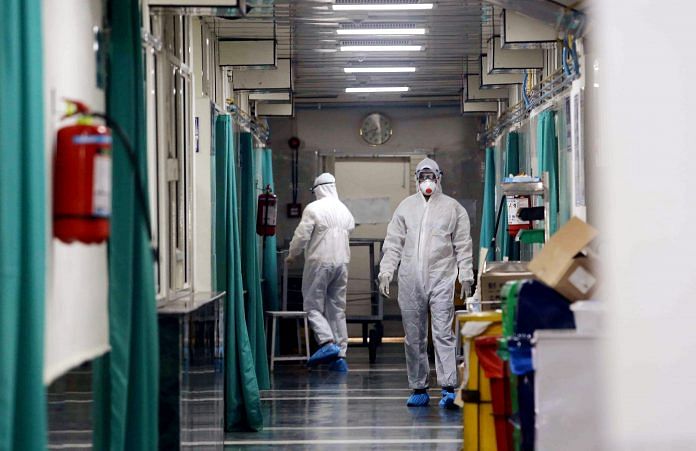The leafy glades around the erstwhile residence of Field Marshal Sir Claude Auchinleck, the last commander-in-chief of the British Army in India, look like they might be holding many secrets, even shrouding a ballroom of yore. Which they do. But they do not look like they are home to one of the most advanced virology laboratories in the country and some of the best brains in the business of disease tracking.
Welcome to the National Centre for Disease Control (NCDC), one of the battlegrounds in India’s war against the Novel Coronavirus disease (COVID-19). It houses, among other things, the IDSP that has been the bulwark of the elaborate contact tracing and active case finding operations across the country for a host of diseases. It is the only programme of its kind with a battery of epidemiologists and public health experts trained in infectious diseases with presence in all Indian states and district level penetration. Though the district and state units are manned by state health officials, IDSP works as part of a unified central command.
Located on the main thoroughfare between the Interstate Bus Terminus at Kashmere Gate – the name a vestige from the time when Delhi was known as the city of seven gates – the unobtrusive campus is of little interest to the thousands that pass by every day. They neither care about the glamorous past that once existed inside nor about the cutting-edge science that is its present. In fact, the NCDC is among the most low-profile organizations under the umbrella of the Ministry of Health and Family Welfare (MoHFW), with an annual budget of a paltry ₹68 crore in 2016–17. NCDC has never been a very important cog in the government of India wheel. But that did not stop the men and women from quietly going about their jobs of tracking and tracing disease outbreaks. They had at their disposal state-of-the-art laboratory facilities, including the potential to do the molecular tests, which would prove to be so important in the fight against the SARS-CoV2 virus. In January 2020 the novel coronavirus though was yet to get its fancy moniker. Its ‘novelty’ remained its calling card.
Also read: India beat Covid ‘doomsday’ prophecies, made ‘monumental strides’ in handling pandemic: ICMR
If there was an Indian medical detective series on emerging infections, the epidemiologists from IDSP would certainly play starring roles. Their work is on par with that of a sleuth – painstaking, detail-oriented and analytical – think Kate Winslet in the movie Contagion. They are forever seeking clues, not to solve a murder mystery but to crack a disease outbreak, with every one of them armed with a compulsive need to investigate every lead.
Speaking to me in his modest office in the impressive NCDC campus sometime in the second quarter of the year, Dr Sujeet Singh, director of the NCDC and IDSP head, recalled the unease in the NCDC in early January about the situation unfolding in China. The unease largely stemmed from institutional memory and the experience of handling numerous outbreaks in the past, including the Nipah outbreak in Kerala in 2018, a Zika cluster in Ahmedabad, and the experience of tracking a clutch of diseases including malaria, dengue, swine flu and Japanese Encephalitis as part of routine functions. But nothing that the disease detectives at NCDC had seen in the past seemed to quite add up to what was happening in China, and brows were already beginning to furrow.
One meeting from this phase with officials from the WHO country office in India had deepened those creases even more.‘This was sometime in the first week of January and they were still telling us that there was nothing to worry about the China situation as there were no cases of human-to-human transmission. Yet the numbers kept piling up and cases were being reported from provinces outside Hubei. Finally, I asked them in one meeting, “How can you say that there is no human-to-human transmission? It is not possible for so many people from across China to be infected from one wet market in Wuhan. Either there are more wet markets in all these provinces from which the virus has emanated, independent of each other and all these cases are index cases, or there is human to human transmission,”’ Dr Singh said to me.
Dr Singh would have known.
Also read: 2 countries that got the coronavirus fight right, and 2 that got it wrong
He had, after all, started his career with the NCDC in 1992 as a young epidemiologist fresh out of college, training under Dr K.K. Dutta, one of NCDC’s most illustrious directors. He conceptualized the IDSP that began in 1996–97 as a pilot project – the National Surveillance Programme for Communicable diseases, first in five districts, then in 101 districts. Dr Singh was among the first batches of officers assigned to the IDSP and had been a part of the team that dealt with some of the biggest disease outbreaks in the country. The need for a national programme for the surveillance of communicable diseases was felt after the plague outbreak of Surat in 1994, and the almost-annual dengue outbreaks in Delhi. The specialized corps of epidemiologists, zoologists, microbiologists, entomologists, clinicians and public health professionals started expanding; by 2004, the programme had a pan-India presence (in varying degrees in various states). Dr Singh had worked his way up the ranks to become the director of the NCDC in 2018 and was, by far, the most experienced man in the government when it came to tackling infectious diseases in the field. The IDSP eventually became the backbone of India’s COVID-19 fightback as the only programme of its kind in the country with tentacles everywhere, down to the district level.
The Central Surveillance Unit (CSU), often loosely referred to as a control room, is administratively and financially integrated with the NCDC in Delhi. There is one State Surveillance Unit (SSU) in each State/UT with a regular officer identified as the State Surveillance Officer (SSO). The person is supported by seven contractual staff members. The District Surveillance Unit (DSU) has one regular officer as District Surveillance Officer (DSO), supported by three contractual staff members. In normal non-pandemic times, the IDSP tracks dengue, chikungunya, Japanese Encephalitis, meningococcal meningitis, typhoid fever, diphtheria, etc. It also tracks dog bites, snake bites, and any other State Specific Disease and Unusual Syndromes. For the duration of COVID-19, almost the entire resources were diverted towards one disease. So much so that data on diseases like flu and dengue was not even updated for the many months of the pandemic. The preoccupation of the health system with COVID caused many other diseases to be neglected throughout the duration of the pandemic. It was only at the fag end of the year that occupancy in private hospitals started picking up under Ayushman Bharat – the flagship health programme of the NDA government under which the eligible families get an annual health insurance of ₹5 lakhs.
 This excerpt from ‘Billions Under Lockdown: The Inside Story of India’s Fight Against Covid-19’ by Abantika Ghosh has been published by Bloomsbury India.
This excerpt from ‘Billions Under Lockdown: The Inside Story of India’s Fight Against Covid-19’ by Abantika Ghosh has been published by Bloomsbury India.






